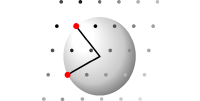Current Events:
-
2nd Erlangen School on Atom Probe Tomography
4. - 8. March 2019
Institute I, Materials Science and Engineering -
GRK 1896 Springschool
18. - 20. March 2019
Pommelsbrunn -
Symposium "Correlative and in situ microscopy in materials research"
1. - 4. April 2019
DPG Frühjahrstagung, Regensburg -
5th CENEM Summer School for X-ray Scattering
29. July - 1. Aug. 2019
Institute for Crystallography and Structural Physics (ICSP)
Organic Photovoltaics
The growing world energy demand intensified the exploration of new power sources.
Photovoltaics offers the ability to generate electricity in a clean and renewable way using the sun light.
In this field organic photovoltaics (OPV) is one of the most promising technologies for low cost
energy production with the advantages of semi-transparency, flexibility and solution processing.
Due to these beneficial and attractive features, great attention was given to the research and
development of higher OPV efficiencies. Recently, a significant breakthrough of over 10% power
conversion efficiency was reported on both polymer- and small molecule-based OPVs. To improve
the performance further investigations on new polymers and new material combinations as well as
new device architectures are conducted. The limited absorption spectrum of organic semiconductors
can be overcome by tandem or multi-junction solar cells as well as ternary organic solar cells
enhancing light harvesting properties and thus the power performance.
The microstructure of the organic solar cell is a crucial factor as it decisively influences the
device performance. The topography and roughness of the individual layers and interfaces as well
as the nanocomposite structure of the active layer are of great interest and need to be elucidated
to understand and improve the device performance. Therfore single layers as well as cross-sections
of the whole devices are investigated with different techniques of scanning electron microscopy (SEM),
analytical transmission electron microscopy (TEM) and scattering methods. Special focus is given to the
elucidation of the nanocomposite structure of the active layer as this is the layer where the power conversion takes place.
Selected publications about the characterization of organic photovoltaics can be found below.
Selected Publications
- Nanowire Interconnects for Printed Large-Area Semitransparent Organic Photovoltaic Modules Fei Guo, Peter Kubis, Thomas Przybilla, Erdmann Spiecker, Andre Hollmann, Stefan Langner, Karen Forberich and Christoph J. Brabec Article first published online: 22 APR 2015 Adv. Energy Mater. 2015 DOI: 10.1002/aenm.201401779
- F. Guo, P. Kubis, N. Li, T. Przybilla, G. Matt, T. Stubhan, T. Ameri, B. Butz, E. Spiecker, K. Forberich and C. J. Brabec Solution-Processed Parallel Tandem Polymer Solar Cells Using Silver Nanowires as Intermediate Electrode ACS Nano (2014), DOI: 10.1021/nn505559w
- F. Guo, X. Zhu, K. Forberich, J. Krantz, T. Stubhan, M. Salinas, M. Halik, S. Spallek, B. Butz, E. Spiecker, T. Ameri, N. Li, P. Kubis, D. M. Guldi, G. J. Matt and C. J. Brabec ITO-Free and Fully Solution-Processed Semitransparent Organic Solar Cells with High Fill Factors Advanced Energy Materials (2013). DOI: 10.1002/aenm.201300100








